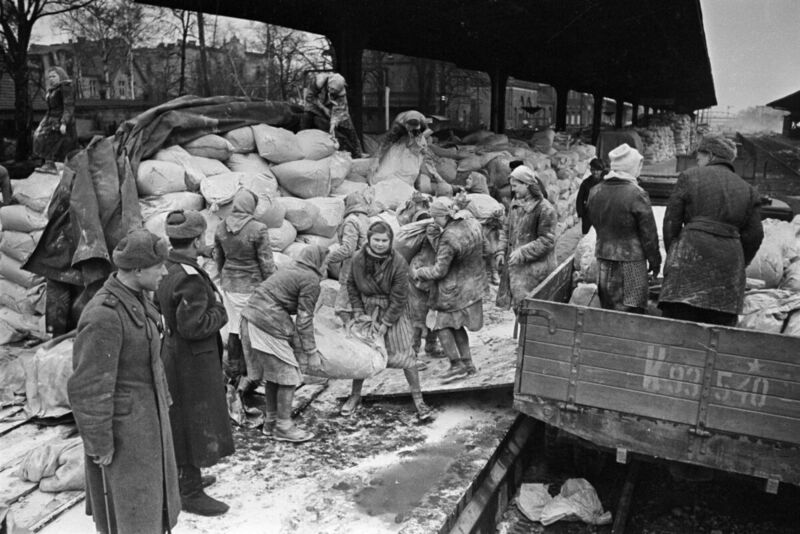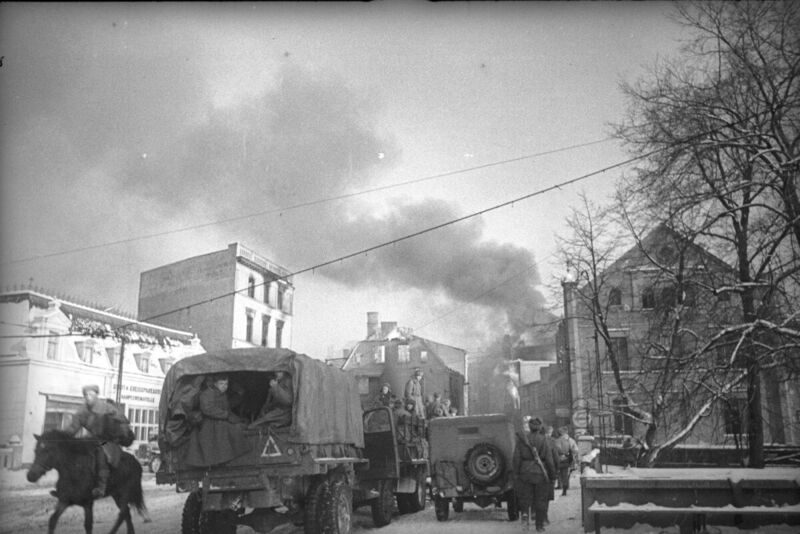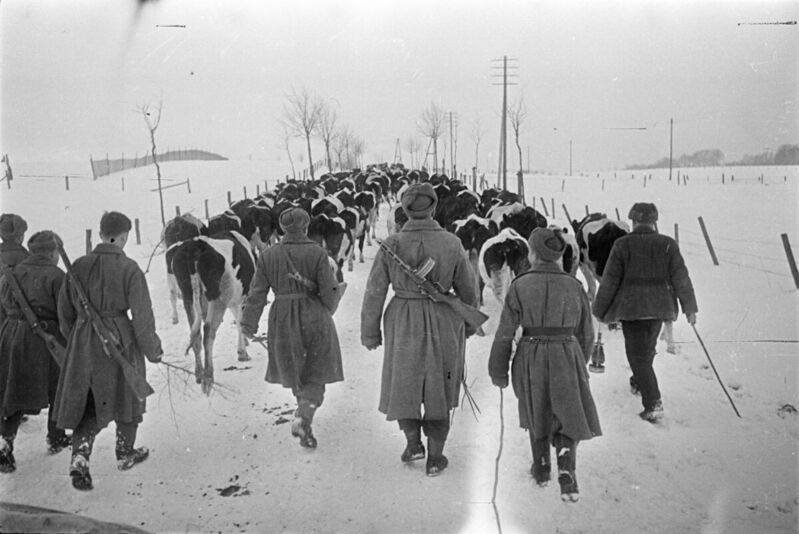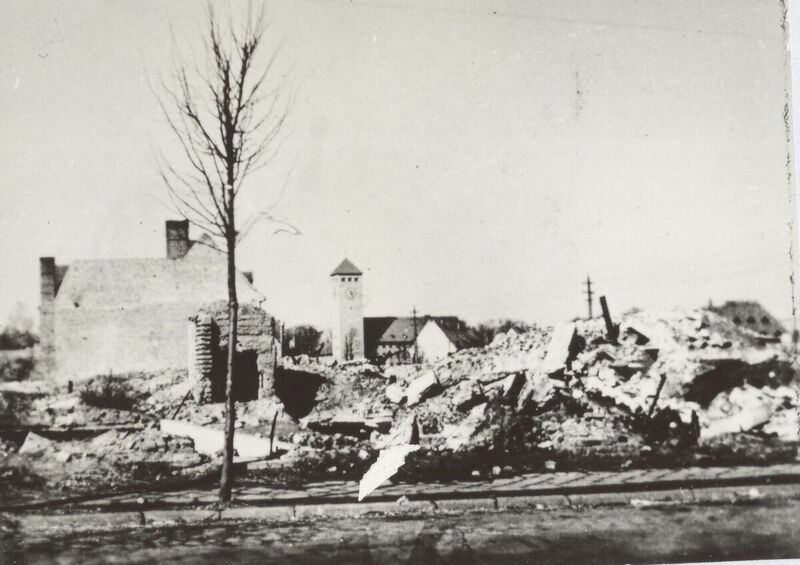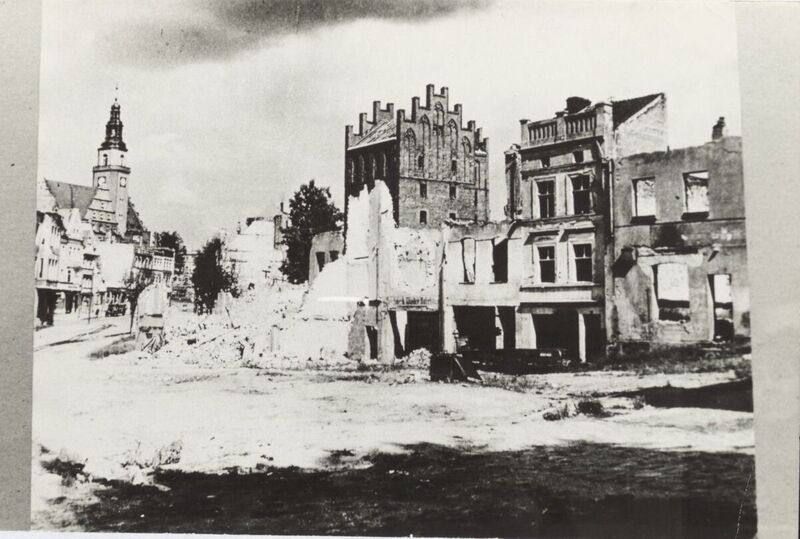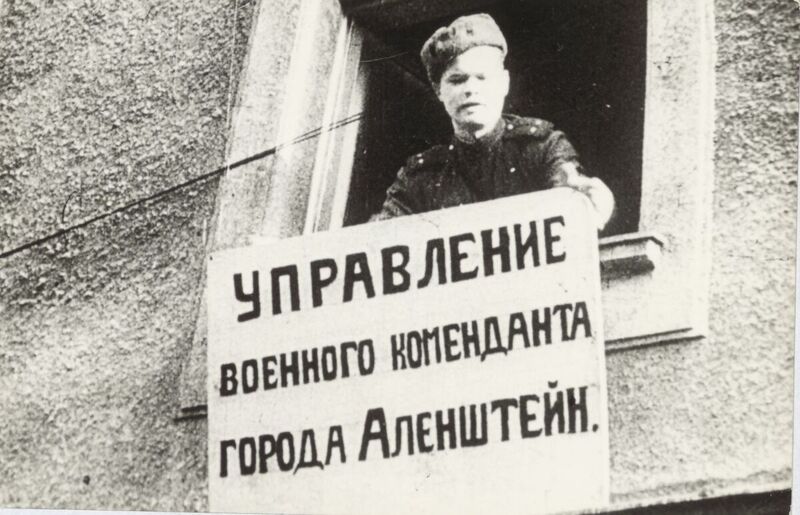”The Red Army entered. They burnt, killed, looted, did as they pleased. No one stopped them. Within a few hours, entire homesteads were turned into ruins. Corpses were scattered along the streets, in gardens, and in the fields. Acts of murder and plunder occurred daily. One resident recalled: On my way, I witnessed terrible things. Elderly women being raped by Russians, not just in one place, but everywhere you looked... [...] I saw a 19-year-old girl, the blacksmith’s daughter, raped by 13 Russians and torn apart in the end. It was horrific; sometimes I wished I didn’t exist in this world,” a resident of the Masurian District recalls the moment of the Red Army’s arrival in 1945 .
In October 1944, the advancing Soviet troops crossed the border into East Prussia. Another offensive in this area began in the winter of 1945. As part of the East Prussian operation, the Red Army launched military operations on the north-eastern front of East Prussia, where, on 13 January, after several days of fierce fighting, they broke through the German defences and captured Olsztyn on 22 January.
After the front advanced, the Soviet military command assumed control of the conquered territories of East Prussia and treated them as enemy territory. Therefore, widespread incidents of looting, destruction, and rapes occurred after the Red Army's occupation, primarily affecting the civilian population. Even as the Soviet side progressively transferred administrative authority to Polish authorities following the cessation of hostilities, the pathological behavior of Red Army soldiers was not curbed.
Information about rapes and murders committed by Red Army soldiers is evident in the majority of official documents and memoirs. According to a report from the Ministry of Public Administration, the population has a negative view of the Red Army due to repeated incidents of theft, looting, sporadic beatings, and acts of rape on women and even children. From another official document: "Soviet soldiers fired several incendiary bullets from a passing car into a farm, resulting in the total destruction of the buildings." One of the district administrators send this alarming report to his superiors: ”Drunken Red Army soldiers broke into a house in Działdowo at night and killed all its residents, a total of 19 people, including 6 Poles and 13 Mazurians.”
On the other hand, the manager of the Anti-Epidemic Column wrote, “A female employee of the Anti-Epidemic Column was abducted by Soviet soldiers from the motorcade and taken about 25 km outside the city, robbed of money and clothing, beaten, and raped by about 30 soldiers. She was also shot in the right leg.” All these descriptions find confirmation in the memoirs of a Soviet officer: ”Women, mothers, and their daughters lie on the sides of the road, and in front of each of them stands a noisy group of men with their pants down. Women who were bleeding or were unconscious were dragged aside, and soldiers shot those who tried to save their children.” In a similar manner, the behaviour of Red Army soldiers was recounted by one of the Polish forced labourers: ”At the crossroads, they decided to turn towards Pisz. After a while, they encountered loose groups of Soviet soldiers, and the ordeal of constant inspections, searching, and requisitions of the carried supplies began. They were threatened with weapons, guns were held against their stomachs, and occasionally a shot was fired, and someone died. A soldier shot a woman who lived nearby because she resisted a rape.”
According to the initial estimates of the Reconstruction Department of the Office of the Plenipotentiary of the Government of the Republic of Poland for the Masurian District of the Republic of Poland, after the Soviets occupied Olsztyn, 1040 buildings were destroyed, which accounted for 36% of the city’s existing structures. However, it is important to note that relatively few buildings were damaged as a result of direct military operations. A significant portion of destruction was caused by Soviet soldiers who set fire to buildings after the cessation of hostilities, without any military justification. This is confirmed by reports from Polish administrative authorities, which state: ”Wherever Red Army troops and units leave the area, the intensity of theft, arson, rape and crimes intensifies where these units stay or pass through”. Deliberate arson by intoxicated Red Army soldiers was not uncommon. This was the case, for instance, in Ek, Kętrzyn, and Olsztyn, where the initial damage was comparatively minor but, after a few weeks, increased and exceeded the initial losses. Numerous streets and neighbourhoods in Olsztyn were entirely destroyed, and nearly half of the buildings in Olsztyn's Old Town were consumed by flames. Similar devastation occurred in the vicinity of streets now known by such names as: Grunwaldzka, Szrajbera, Warszawska, Limanowskiego, Wojska Polskiego, Niepodległości, Knosały, Kościuszki, and Mickiewicza. In a report by Colonel Jakub Prawin, the Plenipotentiary of the Government of the Republic of Poland for the Masurian District, it is stated: ”Towns in the Masurian District were destroyed by 30 to 50%. Military buildings were looted.
Industrial equipment was partially destroyed or taken away by the Soviet military authorities [...]. Public utility facilities such as power plants, gasworks, hospitals, etc., were partially dismantled and partly taken away. Livestock, which was rounded up at estates, has been massively driven eastward for the past two weeks. The remaining movable property, such as furniture, office equipment, warehouse goods, art collections, small artisan workshops, etc., is being looted.” At another time, Colonel Prawin wrote: “The Soviets are taking equipment from workshops and locomotive sheds at individual stations, and they are even dismantling entire railway lines [...]. They load them and take them away.”
A separate mention should be made of Kortowo, where on the night of 21–22 January 1945, the invading Red Army soldiers brutally murdered medical personnel and patients of the psychiatric hospital, and military hospital inpatients, while setting fire to the hospital buildings. In Olsztyn itself, everything was ablaze – from residential houses and tenements to industrial plants. The column of smoke hovered over the city until the end of January 1945. Furthermore, everything that had any value was confiscated and taken away – livestock, factory equipment, agricultural produce, railway tracks, rolling stock, and fleet vehicles, as well as household appliances and utility goods.
In numerous other former East Prussian towns, the Red Army caused even greater devastation. In Braniewo, it reached 80–90%, in Nidzica 75–80%, in Pisz 70–85%, and in Węgorzewo 70–80%. In the Masurian District, official estimates indicate that 19,080 urban properties with a total volume of 23,477.5 thousand cubic meters and a value of nearly 392 million PLN were obliterated or damaged. The Soviet military also destroyed urban sewage and water distribution systems.
The destruction caused by the Red Army soldiers was also evident in the rural areas of the Masurian District. “Marauders committed robberies, looting, and rapes against women. They took away crops and livestock from settlers, and forced the population to work for the military,” as stated in one of Colonel Prawin’s reports . The district administrator (starosta) of Węgorzewo wrote, “Soviet troops looted agricultural equipment from every possible place, regardless of whether it was an area occupied by settlers or a designated landed estate.” According to official data, 17,296 farmsteads with a value of nearly 109 million PLN were destroyed or damaged, accounting for approximately 30% of all rural farmsteads . The situation prevailing in the countryside at that time is evidenced by a fragment of Colonel Prawin’s report: “Plunder, robberies, rapes, and murders committed by units and formations of the Red Army sometimes reach such intensity that terrified populations abandon villages and farmsteads in groups.”
The extent of the destruction was further compounded by losses in livestock, which were initially driven to estates managed by Red Army soldiers and later sent to the USSR. The losses in the headage of farm animals, including cattle, breeding swine, horses, and sheep, amounted to nearly 98%. The district administrator (starosta) of Szczytno reported that the Red Army soldiers “routinely engage in poaching, completely decimating the game, even during protected periods. [...] they invade the homes of personnel during the day and at night, plundering and terrorising the residents.”
Red Army soldiers in the Masurian District also destroyed and looted cultural artefacts, particularly precious handicrafts, paintings, sculptures, and other works of art, as well as the buildings of churches, palaces, libraries, archives, and so on. This resulted in immense losses, the actual estimation of which is impossible today.
A summary of the presence of the Red Army soldiers in the Masurian District is captured in excerpts from the memoirs of Józef Bajgiert, a Polish forced labourer: “The lewd Russians didn’t miss any opportunity; they didn’t honour any rules or morality, and they were not bound by any discipline. Desperate by war, they roamed around, killing and raping depending on their mood. [...] They took whatever they could find–food, drinks, clothes, valuable items, and often worthless things. They were always looking for alcohol through which their temporary great love and friendship could be won. Along the road, burning cars and corpses were scattered. They killed on the spot, out of hatred and revenge, and sometimes for pleasure. There were no ongoing battles nearby; non-war death was rampant.
”Lastly, it is worth mentioning that the repressive activities of the Red Army in the Masurian District did not cease with the transfer of administrative power to Poland in May 1945. In August 1946, the district administrator (starosta) of Szczytno wrote: ”We continually receive complaints from Poland about thefts, robberies, and rapes committed by military units stationed in the county. There have been recent incidents where settlers defending their property were shot, and where soldiers raped their daughters in the presence of their parents.” The Soviets who stationed there in the following months had no intention of giving up their spoils of war, and their actions were often accompanied by the devastation and raping of innocent civilians.
The Monument of Gratitude to Soldiers of the RedArmy – Monument of the Liberation of Warmia and Mazury
The post-war communist authorities in Poland, dependent on the Soviet Union, propagated a false historical narrative for several decades, mandating gratitude to the Red Army for Poland’s “liberation.” Squares and streets were named and monuments were erected in its honour.
In the spring of 1948, the first reports of preparations for the construction of a propaganda installation honoring the Red Army in Olsztyn began to surface. Initially, the monument was to be erected on Red Army Square in Olsztyn (shortly after the square was thus renamed), where a ground-breaking plaque was ceremoniously laid in June 1948 in the presence of central and provincial authorities to mark the construction of the future monument..
The authorities’ approach was typical for that era. They officially avoided imposing any top-down orders to maintain the appearance of democracy.
Decisions made at the highest levels of government were to be put forward as grassroots demands from the public, with which the authorities obviously agreed which they and supported. Trusted individuals, preferably those involved in the activities of social organisations, were used for this purpose. In the case of the propaganda installation in Olsztyn, the initiative was endorsed by the Polish-Soviet Friendship Society (its Olsztyn Branch).
The sculptor Professor Stanisaw Horno-Popawski was the initial creator of the monument's design. The model constructed by the artist was displayed at the Olsztyn Castle. However, the concept was rejected by the communist authorities, who contacted Xawery Dunikowski via the voivode of Olsztyn, Mieczysław Moczar. The sculptor consented to undertake the project at the beginning of 1949 and submitted it by mid-year. During this time, the intended location for the monument's construction changed. A new location was selected close to the Voivodeship Office.
In fact, the sculptures on the Soviet propaganda installation, designed by Dunikowski, were mostly made by his students and employees. Only the soldier’s head was created by the master himself. The people involved in the completion of the monument worked in severe conditions (with snowfall and temperatures dropping to -14 degrees Celsius).
Financial problems in Olsztyn and disputes with the Ministry of Culture and Art regarding the artistic vision delayed the ceremonial unveiling, which finally took place on 21 February 1954. At 11:10 am, the monument was unveiled to the sounds of the Polish and Soviet anthems. At its base, flowers and garlands were then placed.
Due to its design, the Monument of Gratitude has been referred to as the "gallows" since its inception, and the majority of Olsztyn residents believe that it blights the city center. The size of the monument and the name of its designer can leave a lasting impression. However, it should not be forgotten that this is a communist propaganda installation that, for decades, attempted to convince the residents of Olsztyn that the occupation of this territory by the Soviet army was not marked by destruction, violence, and looting, but was instead portrayed as a glorious liberation. Those who perpetrated these heinous acts were citizens of the same nation that invaded and annexed Polish territory in 1939, and then murdered and persecuted millions of Poles in the years that followed. After 1945, they occupied Polish territory rather than liberating it.
More:
The IPN continues decommunization of the public space - Siedlec, Greater Poland
The IPN continues decommunization of the public space - Olsztyn
